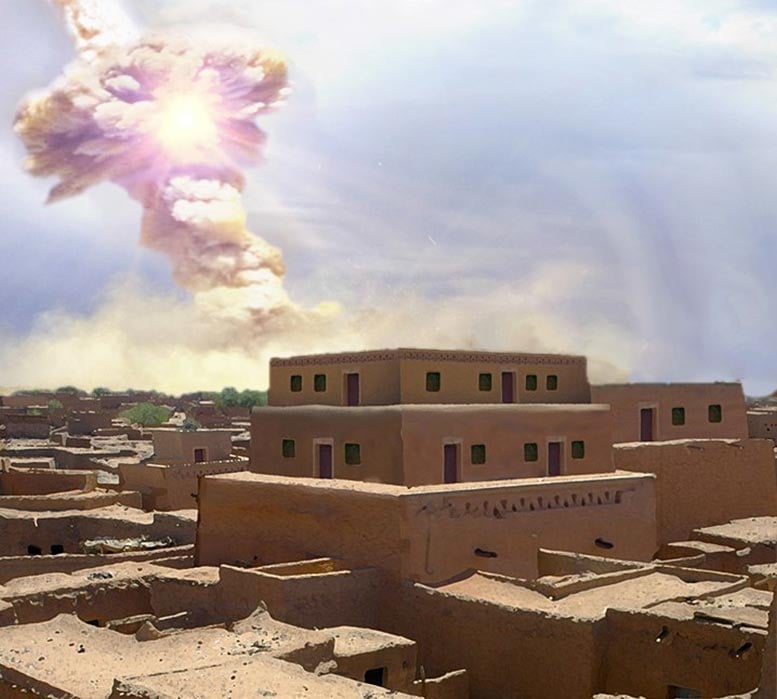
Posted on 09/27/2021 12:01:06 PM PDT by Red Badger

Artist’s evidence-based depiction of the blast, which had the power of 1,000 Hiroshimas. Credit: Allen West and Jennifer Rice
A giant space rock demolished an ancient Middle Eastern city and everyone in it – possibly inspiring the Biblical story of Sodom.
As the inhabitants of an ancient Middle Eastern city now called Tall el-Hammam went about their daily business one day about 3,600 years ago, they had no idea an unseen icy space rock was speeding toward them at about 38,000 mph (61,000 kph).
Flashing through the atmosphere, the rock exploded in a massive fireball about 2.5 miles (4 kilometers) above the ground. The blast was around 1,000 times more powerful than the Hiroshima atomic bomb. The shocked city dwellers who stared at it were blinded instantly. Air temperatures rapidly rose above 3,600 degrees Fahrenheit (2,000 degrees Celsius). Clothing and wood immediately burst into flames. Swords, spears, mudbricks, and pottery began to melt. Almost immediately, the entire city was on fire.
Some seconds later, a massive shockwave smashed into the city. Moving at about 740 mph (1,200 kph), it was more powerful than the worst tornado ever recorded. The deadly winds ripped through the city, demolishing every building. They sheared off the top 40 feet (12 m) of the 4-story palace and blew the jumbled debris into the next valley. None of the 8,000 people or any animals within the city survived – their bodies were torn apart and their bones blasted into small fragments.
About a minute later, 14 miles (22 km) to the west of Tall el-Hammam, winds from the blast hit the biblical city of Jericho. Jericho’s walls came tumbling down and the city burned to the ground.
It all sounds like the climax of an edge-of-your-seat Hollywood disaster movie. How do we know that all of this actually happened near the Dead Sea in Jordan millennia ago?
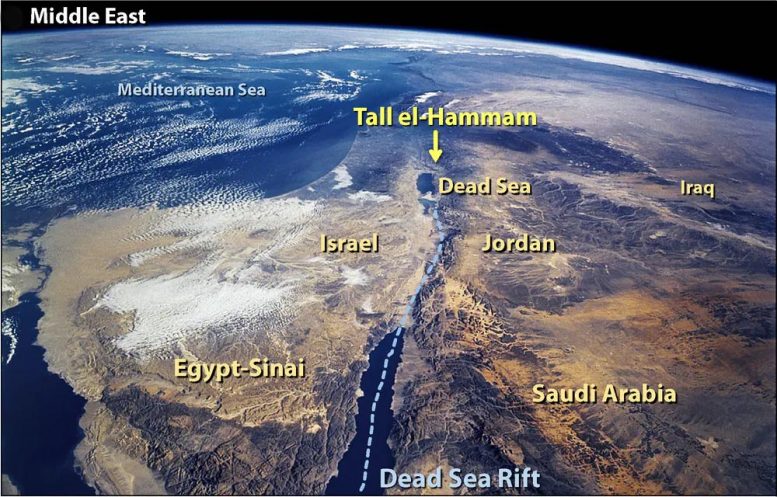
Now called Tall el-Hammam, the city is located about 7 miles northeast of the Dead Sea in what is now Jordan. Credit: NASA
Getting answers required nearly 15 years of painstaking excavations by hundreds of people. It also involved detailed analyses of excavated material by more than two dozen scientists in 10 states in the U.S., as well as Canada and the Czech Republic. When our group finally published the evidence recently in the journal Scientific Reports, the 21 co-authors included archaeologists, geologists, geochemists, geomorphologists, mineralogists, paleobotanists, sedimentologists, cosmic-impact experts and medical doctors.
Here’s how we built up this picture of devastation in the past.
Firestorm throughout the city Years ago, when archaeologists looked out over excavations of the ruined city, they could see a dark, roughly 5-foot-thick (1.5 m) jumbled layer of charcoal, ash, melted mudbricks and melted pottery. It was obvious that an intense firestorm had destroyed this city long ago. This dark band came to be called the destruction layer.
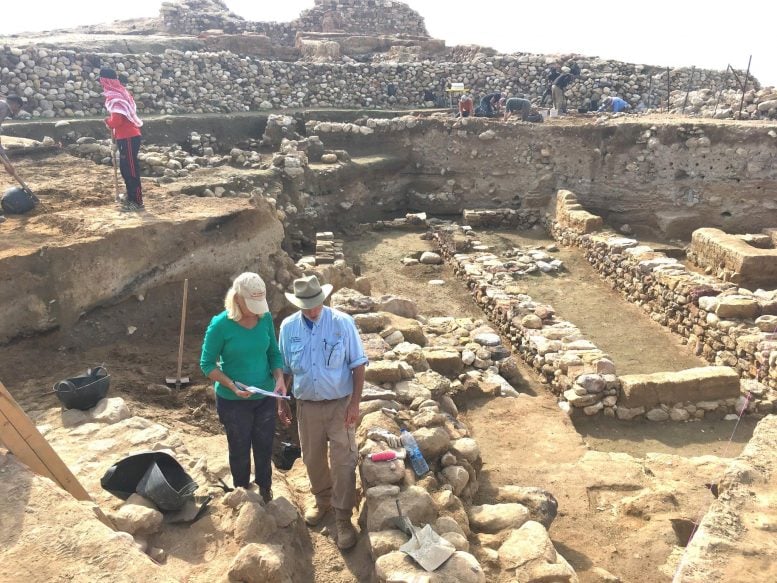
Researchers stand near the ruins of ancient walls, with the destruction layer about midway down each exposed wall. Credit: Phil Silvia
No one was exactly sure what had happened, but that layer wasn’t caused by a volcano, earthquake or warfare. None of them are capable of melting metal, mudbricks and pottery.
To figure out what could, our group used the Online Impact Calculator to model scenarios that fit the evidence. Built by impact experts, this calculator allows researchers to estimate the many details of a cosmic impact event, based on known impact events and nuclear detonations.
It appears that the culprit at Tall el-Hammam was a small asteroid similar to the one that knocked down 80 million trees in Tunguska, Russia in 1908. It would have been a much smaller version of the giant miles-wide rock that pushed the dinosaurs into extinction 65 million ago.
We had a likely culprit. Now we needed proof of what happened that day at Tall el-Hammam.
Finding ‘diamonds’ in the dirt Our research revealed a remarkably broad array of evidence.
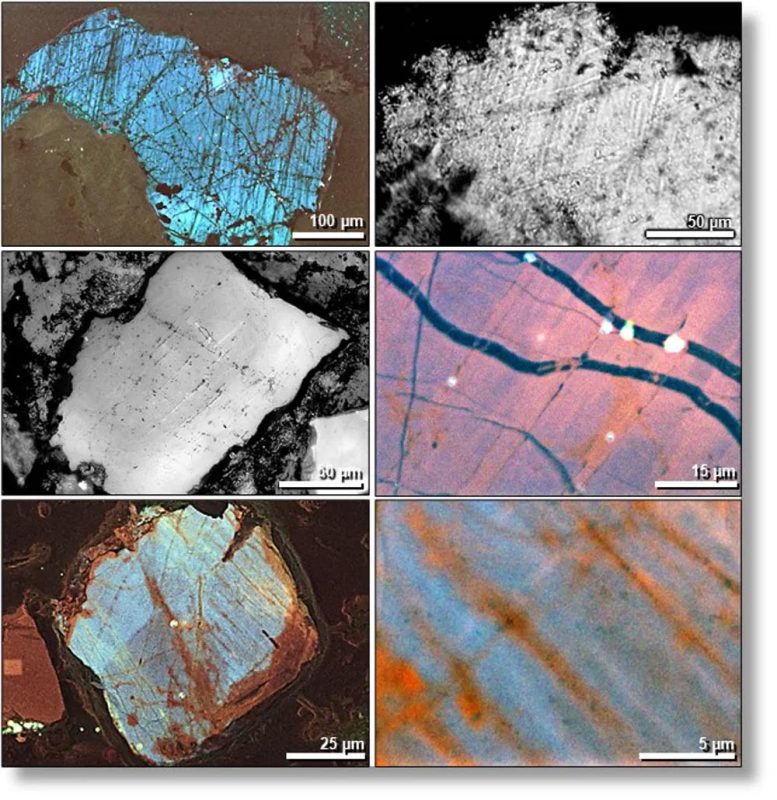
Electron microscope images of numerous small cracks in shocked quartz grains. Credit: Allen West
At the site, there are finely fractured sand grains called shocked quartz that only form at 725,000 pounds per square inch of pressure (5 gigapascals) – imagine six 68-ton Abrams military tanks stacked on your thumb.
The destruction layer also contains tiny diamonoids that, as the name indicates, are as hard as diamonds. Each one is smaller than a flu virus. It appears that wood and plants in the area were instantly turned into this diamond-like material by the fireball’s high pressures and temperatures.
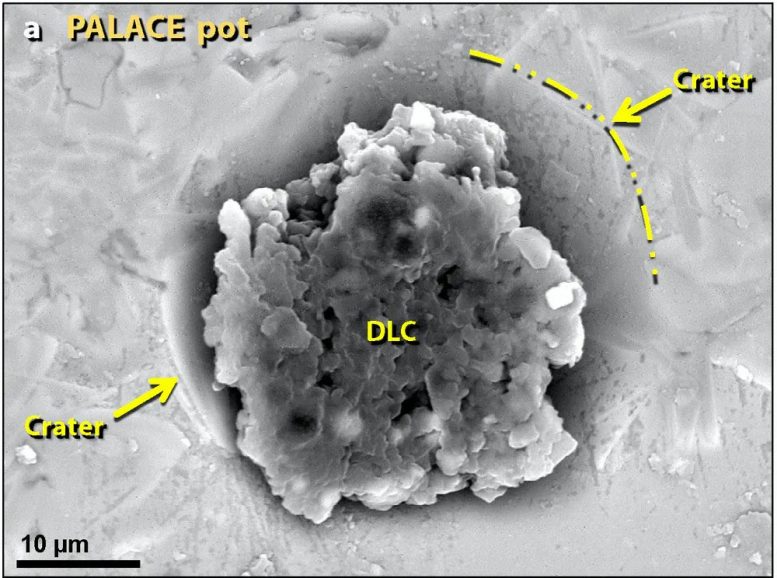
Diamonoids (center) inside a crater were formed by the fireball’s high temperatures and pressures on wood and plants. Credit: Malcolm LeCompte
Experiments with laboratory furnaces showed that the bubbled pottery and mudbricks at Tall el-Hammam liquefied at temperatures above 2,700 F (1,500 C). That’s hot enough to melt an automobile within minutes.
The destruction layer also contains tiny balls of melted material smaller than airborne dust particles. Called spherules, they are made of vaporized iron and sand that melted at about 2,900 F (1,590 C).
In addition, the surfaces of the pottery and meltglass are speckled with tiny melted metallic grains, including iridium with a melting point of 4,435 F (2,466 C), platinum that melts at 3,215 F (1,768 C) and zirconium silicate at 2,800 F (1,540 C).
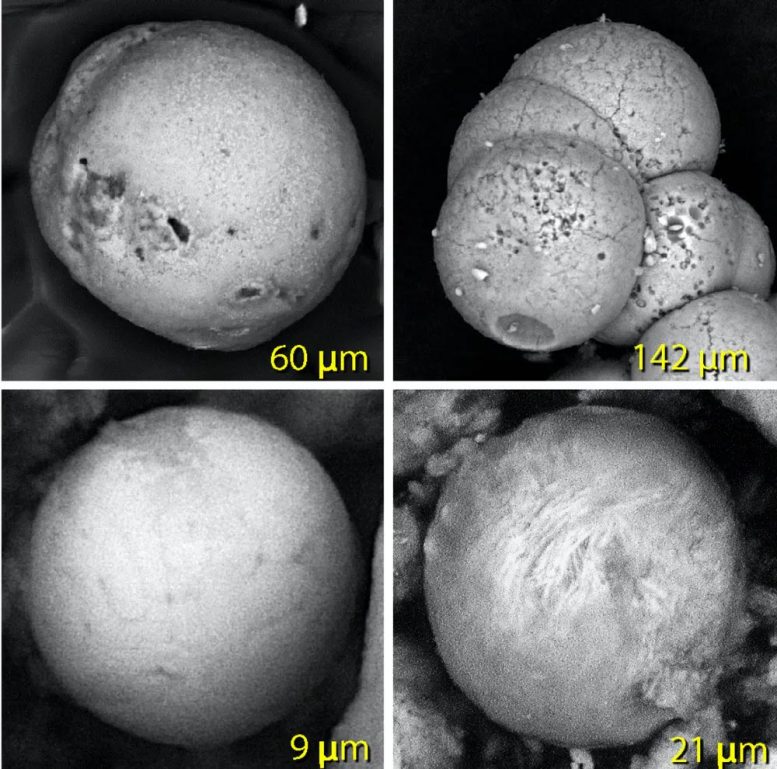
Spherules made of melted sand (upper left), palace plaster (upper right) and melted metal (bottom two). Credit: Malcolm LeCompte
Together, all this evidence shows that temperatures in the city rose higher than those of volcanoes, warfare and normal city fires. The only natural process left is a cosmic impact.
The same evidence is found at known impact sites, such as Tunguska and the Chicxulub crater, created by the asteroid that triggered the dinosaur extinction.
One remaining puzzle is why the city and over 100 other area settlements were abandoned for several centuries after this devastation. It may be that high levels of salt deposited during the impact event made it impossible to grow crops. We’re not certain yet, but we think the explosion may have vaporized or splashed toxic levels of Dead Sea salt water across the valley. Without crops, no one could live in the valley for up to 600 years, until the minimal rainfall in this desert-like climate washed the salt out of the fields.
Was there a surviving eyewitness to the blast? It’s possible that an oral description of the city’s destruction may have been handed down for generations until it was recorded as the story of Biblical Sodom. The Bible describes the devastation of an urban center near the Dead Sea – stones and fire fell from the sky, more than one city was destroyed, thick smoke rose from the fires and city inhabitants were killed.
Could this be an ancient eyewitness account? If so, the destruction of Tall el-Hammam may be the second-oldest destruction of a human settlement by a cosmic impact event, after the village of Abu Hureyra in Syria about 12,800 years ago. Importantly, it may the first written record of such a catastrophic event.
The scary thing is, it almost certainly won’t be the last time a human city meets this fate.

Animation depicting the positions of known near-Earth objects at points in time for the 20 years ending in January 2018. Credit: NASA/JPL-Caltech
Tunguska-sized airbursts, such as the one that occurred at Tall el-Hammam, can devastate entire cities and regions, and they pose a severe modern-day hazard. As of September 2021, there are more than 26,000 known near-Earth asteroids and a hundred short-period near-Earth comets. One will inevitably crash into the Earth. Millions more remain undetected, and some may be headed toward the Earth now.
Unless orbiting or ground-based telescopes detect these rogue objects, the world may have no warning, just like the people of Tall el-Hammam.
Written by Christopher R. Moore, Archaeologist and Special Projects Director at the Savannah River Archaeological Research Program and South Carolina Institute for Archaeology and Anthropology, University of South Carolina.
This article was co-authored by research collaborators archaeologist Phil Silvia, geophysicist Allen West, geologist Ted Bunch and space physicist Malcolm LeCompte.
This article was first published in The Conversation. For more on this research, see Sodom and Gomorrah? Evidence That a Cosmic Impact Destroyed a Biblical City in the Jordan Valley.
Actually, we know what inspired the Biblical story of Sodom. Why do you think they call it . . .
As would be Shadow Band...
What goes up must come down. When Santorini blew up 23 miles into the sky in 1646-1650 B.C., were there any big pieces that went up and then came down? Coincidental that Crete, Ur, , Sodom and Gomorroa, 13th Dynasty Egypt and Harappan all got wiped out circa 1650. It cannot be by chance that Santorini blew up and an asteroid broke into mutliple airbursts at the same time? The odds are against
such an occurrence. Scientists say an airburst over the Dead Sea 1650 B.C. occurred. Is this a chunk of the Santorini volcano going up 23 miles, coming back down over these places and causing airbursts? The chunk the was blasted out of Santorini was 5 miles wide and 10 miles long. Ur, Giza, Harrapan, etc are all in the same eastern arc path...
Thatsa bigga meat ball!

Quoi?
“ As the inhabitants of an ancient Middle Eastern city now called Tall el-Hammam went about their daily business one day about 3,600 years ago…”
I was wondering if “their daily business” included bending over and grabbing their ankles.
During a State of Union speech would be ideal. The headline afterwards would be 'The State of the Union has been wiped clean'
I thought this would be roughly in the Sodom and Gomorrah metropolitan area.
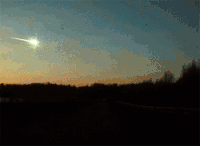
Whoop! There it is!
Just last week a large asteroid passed between the Moon and Earth coming from the direction of the Sun. NASA did not see it until it was between the Moon and Earth.
I hope it hits my neighbor's house. He always plays his radio too loud. 🏠🌠
-PJ
A couple of cities in the ancient near east (we're talking about maybe 10,000 people) get real unlucky in the matter of being in the way of a meteor.
This is of course yet another case of a meaningless horror in an uncaring universe. But their neighbors make up a story about or one of the gods punishing them for something or other (probably hubris) just so the universe can make some sense.
A few centuries later, some Only One God homophobes wrote down their version of what happened and said it was because those guys were homos.
Right? Right? /smirk

“Actually, we know what inspired the Biblical story of Sodom. Why do you think they call it . . .”
Note that at that point in time, there was no Ten Commandments and no Hebrew Bible, in which the prohibition against “a man laying with another man as a woman” was first stated.
SMOD ping.
Don’t piss off God. Keep that in mind LA, New York, Chicago, etc., etc.
I went back and checked, it mentioned Jericho and sG
Also, there has never been an archaeological discovery which has disproved events recorded in the Bible. NEVER.
That is a very impressive fact.
Keep that in mind when someone tries to use science to refute God’s Word.
Thanks, no ping, because, well look (and I think there are at least three more new ones):
A recently published paper is making the bold claim that there's evidence that an ancient, bronze age city was destroyed by an asteroid air burst. It's got a lot of attention because this is being linked to a story in the Hebrew Bible which is a core text in Judaism, Christianity and Islam. However, many scientists with expertise in the field are unconvinced.
This is the paper in question, published in 'Scientific Reports' the open access side of Nature with lower bar for entry than the flagship publication.There's a related paper from some of the authors talking about another city in a similar location also destroyed by an airburst.
- A Tunguska sized airburst destroyed Tall el-Hammam a Middle Bronze Age city in the Jordan Valley near the Dead Sea | Ted E. Bunch, Malcolm A. LeCompte, A. Victor Adedeji, James H. Wittke, T. David Burleigh, Robert E. Hermes, Charles Mooney, Dale Batchelor, Wendy S. Wolbach, Joel Kathan, Gunther Kletetschka, Mark C. L. Patterson, Edward C. Swindel, Timothy Witwer, George A. Howard, Siddhartha Mitra, Christopher R. Moore, Kurt Langworthy, James P. Kennett, Allen West & Phillip J. Silvia | Scientific Reports volume 11, Article number: 18632 (2021)
- Evidence of Cosmic Impact at Abu Hureyra, Syria at the Younger Dryas Onset (~12.8 ka): High-temperature melting at 2200 °C | Andrew M. T. Moore, James P. Kennett, William M. Napier, Ted E. Bunch, James C. Weaver, Malcolm LeCompte, A. Victor Adedeji, Paul Hackley, Gunther Kletetschka, Robert E. Hermes, James H. Wittke, Joshua J. Razink, Michael W. Gaultois & Allen West | Scientific Reports volume 10, Article number: 4185 (2020)
Did An Asteroid Destroy A Biblical City? Take These Claims With a Pillar Of Salt | September 25, 2021 | Scott Manley

Disclaimer: Opinions posted on Free Republic are those of the individual posters and do not necessarily represent the opinion of Free Republic or its management. All materials posted herein are protected by copyright law and the exemption for fair use of copyrighted works.